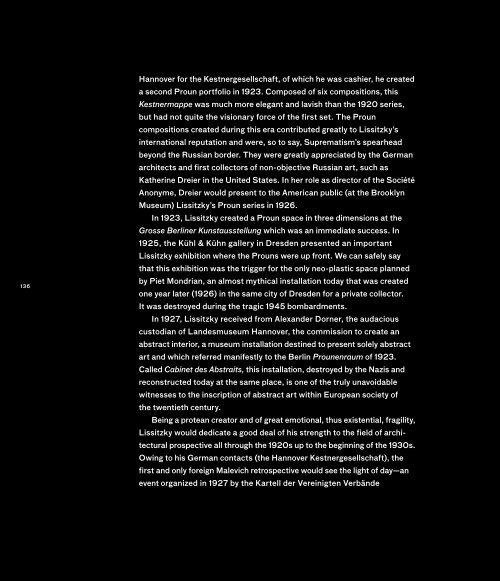Andrei Nakov – Forms in Dissolution / Kazimir Malevich, Carré rouge / El Lissitzky, Proun
Excerpt from the book “Zaha Hadid and Suprematism”, published by Galerie Gmurzynska in collaboration with Hatje Cantz on the occasion of an exhibition at the gallery space in Zurich, designed by Zaha Hadid and Patrik Schumacher.
Excerpt from the book “Zaha Hadid and Suprematism”, published by Galerie Gmurzynska in collaboration with Hatje Cantz on the occasion of an exhibition at the gallery space in Zurich, designed by Zaha Hadid and Patrik Schumacher.
You also want an ePaper? Increase the reach of your titles
YUMPU automatically turns print PDFs into web optimized ePapers that Google loves.
136<br />
Hannover for the Kestnergesellschaft, of which he was cashier, he created<br />
a second <strong>Proun</strong> portfolio <strong>in</strong> 1923. Composed of six compositions, this<br />
Kestnermappe was much more elegant and lavish than the 1920 series,<br />
but had not quite the visionary force of the first set. The <strong>Proun</strong><br />
compositions created dur<strong>in</strong>g this era contributed greatly to <strong>Lissitzky</strong>’s<br />
<strong>in</strong>ternational reputation and were, so to say, Suprematism’s spearhead<br />
beyond the Russian border. They were greatly appreciated by the German<br />
architects and first collectors of non-objective Russian art, such as<br />
Kather<strong>in</strong>e Dreier <strong>in</strong> the United States. In her role as director of the Société<br />
Anonyme, Dreier would present to the American public (at the Brooklyn<br />
Museum) <strong>Lissitzky</strong>’s <strong>Proun</strong> series <strong>in</strong> 1926.<br />
In 1923, <strong>Lissitzky</strong> created a <strong>Proun</strong> space <strong>in</strong> three dimensions at the<br />
Grosse Berl<strong>in</strong>er Kunstausstellung which was an immediate success. In<br />
1925, the Kühl & Kühn gallery <strong>in</strong> Dresden presented an important<br />
<strong>Lissitzky</strong> exhibition where the <strong>Proun</strong>s were up front. We can safely say<br />
that this exhibition was the trigger for the only neo-plastic space planned<br />
by Piet Mondrian, an almost mythical <strong>in</strong>stallation today that was created<br />
one year later (1926) <strong>in</strong> the same city of Dresden for a private collector.<br />
It was destroyed dur<strong>in</strong>g the tragic 1945 bombardments.<br />
In 1927, <strong>Lissitzky</strong> received from Alexander Dorner, the audacious<br />
custodian of Landesmuseum Hannover, the commission to create an<br />
abstract <strong>in</strong>terior, a museum <strong>in</strong>stallation dest<strong>in</strong>ed to present solely abstract<br />
art and which referred manifestly to the Berl<strong>in</strong> <strong>Proun</strong>enraum of 1923.<br />
Called Cab<strong>in</strong>et des Abstraits, this <strong>in</strong>stallation, destroyed by the Nazis and<br />
reconstructed today at the same place, is one of the truly unavoidable<br />
witnesses to the <strong>in</strong>scription of abstract art with<strong>in</strong> European society of<br />
the twentieth century.<br />
Be<strong>in</strong>g a protean creator and of great emotional, thus existential, fragility,<br />
<strong>Lissitzky</strong> would dedicate a good deal of his strength to the field of architectural<br />
prospective all through the 1920s up to the beg<strong>in</strong>n<strong>in</strong>g of the 1930s.<br />
Ow<strong>in</strong>g to his German contacts (the Hannover Kestnergesellschaft), the<br />
first and only foreign <strong>Malevich</strong> retrospective would see the light of day—an<br />
event organized <strong>in</strong> 1927 by the Kartell der Vere<strong>in</strong>igten Verbände
















